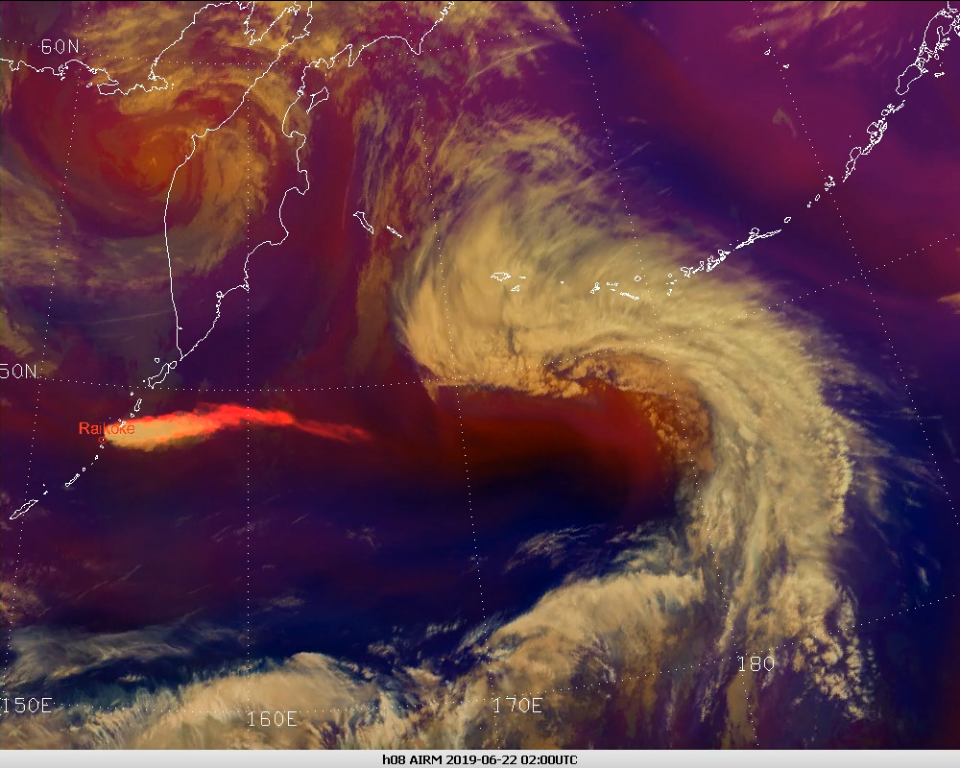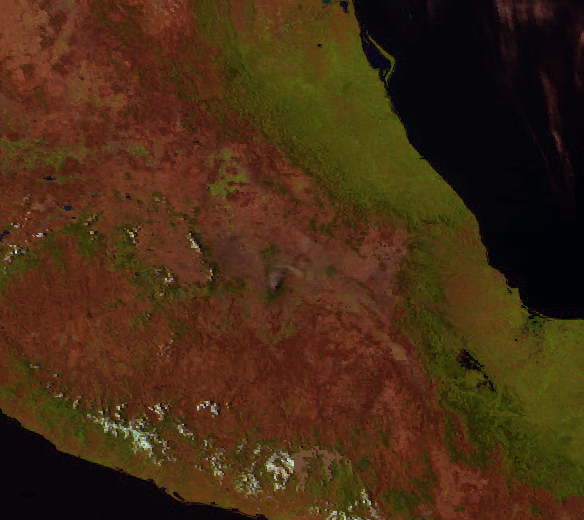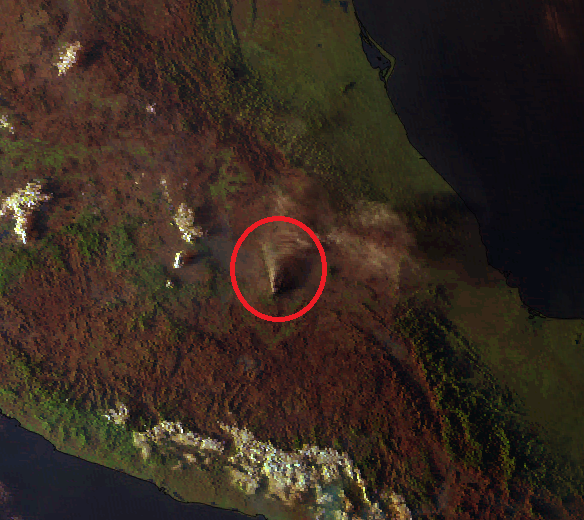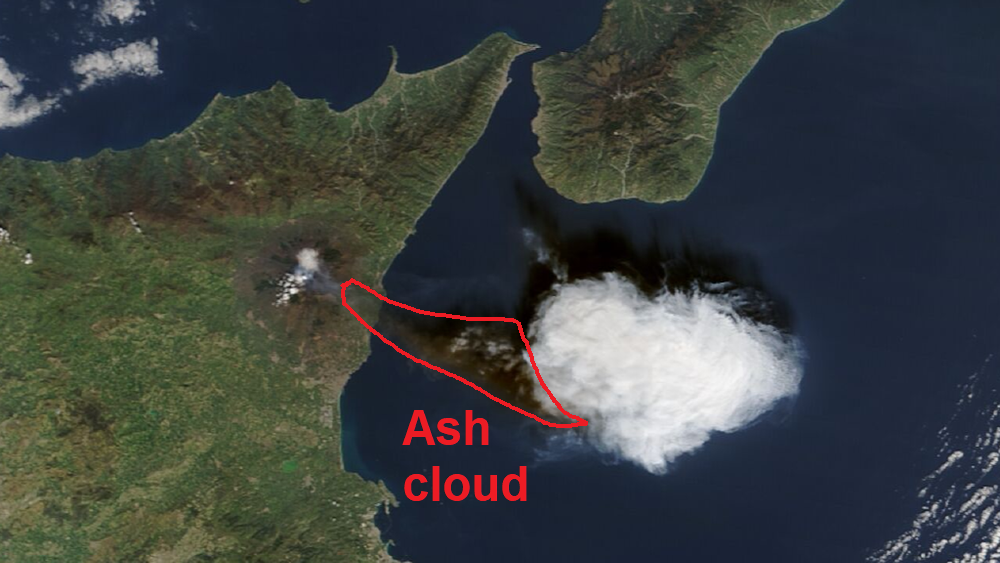Chapter II: The appearance of volcanic ash clouds in selected spectral bands and RGB types
2. The appearance of volcanic ash clouds in selected spectral bands and RGB types
Figure 10: Hunga Tonga-Hunga Ha'apai volcanic eruption January 14, 2022, Source: Wikipedia © Tonga Geological Services, CC BY
The constituents of volcanic plumes such as volcanic ash, water vapor and SO2 can be observed in visible and infrared channels from polar orbiting and geostationary satellites. The movement of the volcanic plumes can be easily followed in animations of satellite images.
Volcanic ash and gases are often mixed in proximity to the source, but they can also be separated at the onset of eruptions, possibly due to differences in injection height. In the latter case, volcanic plumes are seen to follow different routes in cases of vertical wind shear.
Generally, larger ash particles and lapilli are first to deposit after being ejected. Only the smallest ash particles (smaller than 5 microns) remain airborne over a period of days, depending on ejection height. When volcanic ash is released, about 98% of fine ash (1 to 10 microns) is removed by gravitational deposition within 3 to 4 days. However, low ash concentrations are hard to detect for the sensors of satellites whose primary purpose is to monitor water and ice clouds.
SO2 is removed by chemical reaction and conversion to sulphate aerosol, which, as with volcanic ash, is then deposited predominantly by gravitational forces. In many eruptions, the SO2 cloud is seen circling the Earth before it becomes thinned out.
The following sections provide a detailed overview on the spectral channel combinations used to detect volcanic plumes.
2.1 The Volcanic Ash RGB
Figure 11: Meteosat-11 Ash RGB, Mount Etna eruption on 7 March 2021, 06:00 - 14:30 UTC. © EUMETSAT
To better monitor volcanic ash clouds and gases continuously day and night, specific infrared channels are combined to form the Ash RGB. The same channel combination is used for the 24-hour Microphysical and the Dust RGB, but the Ash RGB product is tuned to detect SO2 and ash clouds typical of volcanic eruptions.
All three RGBs use the same infrared channels but differ in the applied temperature thresholds and image enhancements (i.e., gamma correction). Although the Volcanic Ash RGB has been tuned to highlight volcanic ash clouds and SO2 gases, the other two RGB types can also be used to monitor volcanic eruptions, albeit with less overall efficiency.
The Volcanic Ash RGB exploits the fact that thin ash clouds tend to have a positive brightness temperature difference (BTD) between SEVIRI channels IR12.0 and IR10.8, while water/ice clouds (and thin ice clouds in particular) have a negative BTD (Figure 12). The same radiation pattern is used in the Dust RGB to detect suspended mineral dust particles. Thus, in thin ash clouds the red color beam features prominently (Table 1), whilst water/ice clouds have less red, and thin ice clouds in particular appear very dark. Depending on the height of the ash cloud and hence on its temperature, ash clouds are depicted in red when the cloud is colder and in magenta (= red + blue) when the cloud is warmer.
Figure 12: Transmission through thin ash and thin ice clouds, © COMET
Mineral ash particles can act as ice condensation nuclei and form thin cirrus clouds. Hence, they are depicted in black in the Volcanic Ash RGB (Figure 13).
In addition, the Ash RGB exploits the SO2 absorption band at around 8.6 µm (SEVIRI IR8.7 channel). The BTD [IR10.8 - IR8.7] is positive when SO2 is present in the atmosphere, resulting in a strong contribution of the green color beam (Table 1 and 2).
If both constituents are present, the mixed ash cloud appears yellow (= red + green) (Figure 13).
Table 1: SEVIRI channels used for the Volcanic Ash RGB.
Table 2: Temperature thresholds used for the SEVIRI channels of the Volcanic Ash RGB.
Under certain conditions, the 24h Microphysical RGB or the Dust RGB may perform even better than the Volcanic Ash RGB, especially when the viewing angle is strongly inclined, the ash concentration very high or the cloud temperature very cold. Nevertheless, the Volcanic Ash RGB is a good all-rounder for depicting most volcanic plumes.
Figure 13: Suomi-NPP Volcanic Ash RGB, 19 February 2018, 06:06 UTC. © NASA
More about the Volcanic Ash RGB:
- Quick Guide
- CAL module on the Volcanic Ash RGB
2.2 The Airmass RGB
Figure 14: Meteosat-10 Airmass RGB, Calbuco eruption between 23 April 00:00 UTC and 27 April 06:00 UTC. © EUMETSAT
Although not designed for SO2 monitoring, the Airmass RGB can exploit the strong SO2 absorption band at around 7.3 µm (SEVIRI WV7.3 channel), and as long as the SO2 plume is higher than 3 km it detects high SO2 concentrations fairly well. The cooling effect of the SO2 cloud on the WV7.3 channel (Table 3) leads to small a BTD between the WV6.2 and WV7.3 channels, which is seen in the red component of the Airmass RGB. Thus, mid/high-level SO2 clouds from volcanic eruptions appear red to orange in this RGB composite.
Volcanic ash particles on the other side tend to reduce the BTD [IR9.7 - IR10.8] as it cools the IR10.8 window channel down to values similar to the Ozone absorbing channel IR9.7. Pure ash clouds usually appear pale green in the Airmass RGB. However, in a warm air mass, pure ash clouds are difficult to see in the Airmass RGB because the background has the same color tone. Note that the red and the green color have the opposite meaning in the Airmass RGB when compared to the Volcanic Ash RGB.
Table 3: Temperature thresholds used for the SEVIRI channels of the Airmass RGB
In case SO2 and ash are mixed in the same cloud, colors can vary from magenta (less ash) to yellow (more ash), depending on the ratio. Usually, the mixed form of ash and sulphur clouds is found close to the volcano. As the ash particles tend to deposit over time, the mixed cloud becomes a SO2 cloud, which is often seen travelling long distances. This means that mixed clouds undergo a color transformation from yellow (higher ash concentration) to magenta and red (all ash has deposited). Additionally, the SO2 signal becomes stronger in the Airmass RGB with increasing viewing angle (i.e., at the limb of the image).
|
|
Figure 15: Himawari- 8 Airmass RGBs, 22 June 2019 at 02:00 and 14:30 UTC, eruption of Mount Raikoke. Use the slider to compare both images.
Figure 16: Himawari- 8 Airmass RGBs, 22 June 2019 at 06:00 UTC, eruption of Mount Raikoke
More about the Airmass RGB:
- Quick Guide
- CAL module on the Volcanic Ash RGB
Quiz
Mount Nyamuragira erupted in November 2006. On 29 November, a large ash/SO2 plume could be observed in the Airmass RGB.
Which constituent of the volcanic plume is visible in this Airmass RGB image?
2.3 Visible channel combinations for detecting ash and smoke clouds
Figure 17: Himawari-8 True Color RGB, Sinabung eruption on 19 February 2018 01:00 - 11:00 UTC
Visible channels are sensitive to small aerosol particles such as smoke, mineral dust and volcanic ash suspended in the atmosphere. The detection sensitivity of small aerosol particles increases with smaller wavelengths. For the SEVIRI instrument on geostationary MSG satellites, this sensitivity ends for particle sizes at around 25 µm. Below this threshold, suspended aerosols remain invisible for the scanning instrument. However, and in contrast to infrared channels, visible channels cannot depict trace gases that are constituents of volcanic plumes.
Visible channels have two main advantages when compared to infrared channels:
- They often have a better spatial resolution than infrared channels
- They can show low-level ash clouds better than infrared channels when the temperature contrast between cloud and ground is marginal
The Natural Color RGB
The Natural Color RGB combines two visible channels with a near-infrared channel. The advantage of using two visible channels is to include cloud optical thickness information into the RGB product to make thick volcanic ash plumes more visible in the Natural Color RGB (Figure 18). Generally, ash plumes are easier to distinguish over sea than over land because of the stronger contrast with dark surface water. Moreover, this RGB's ability to depict surface characteristics helps detect ash deposits on vegetation.
Additionally, the red color beam (NIR1.6), being sensitive to very hot surfaces, gives a clear signal if lava is present (hot spot, Figure 18). For the same reason, this channel is also used in the Fire Temperature RGB.
Figure 18: Suomi-NPP Natural Colour RGB, Mount Majon eruption on 22 January 2018 at 05:20 UTC.
The solar incidence angle has a considerable effect on ash plume visibility when using the Natural Color RGB. The ash plume is much more visible in the evening hours at low solar incidence angles (Figure 19). Moreover, the whole image gets a 3-dimensional character.
Mount Popocatépetl erupted in February 2024, spewing out an ash plume in a northerly direction. This ash plume is perfectly visible in dusk conditions (00:00 UTC), but barely noticeable three hours before.
|
|
Figure 19: GOES-West Natural Colour RGB, Mount Popocatépetl eruption on 27 and 28 February 2024 at 21:00 and 00:00 UTC respectively. Use the slider to see the difference.
The True Color RGB
The True Color RGB combines spectral bands in the red, green and blue segments of the solar spectrum. Compared to the Natural Color RGB, it uses spectral bands even deeper into the short-wave spectrum, enhancing its capabilities for detecting atmospheric aerosols such as ash clouds composed of very small particles.
The advantage True Color images have over Natural Color images is their similarity to how humans perceive a given view (Figure 20). Their downside is the loss of information provided by the NIR1.6 channel regarding cloud microphysical properties, such as discrimination between ice and water phases or particle size, and the loss of thermal information, such as hot lava spots.
Figure 20: MODIS/Terra True Color image, Grimsvötn eruption on 22 May 2011 at 05:15 UTC.
More about the Natural Color and True Color RGB:
- Quick Guide Natural Color RGB
- Quick Guide True Color RGB
- CAL module on the Natural Color RGB
Quiz
On 28 February 2021, an ash/SO2 plume is visible two hours after the start of the eruption of Mount Etna.
Mark the ash cloud visible in the True Color RGB.














